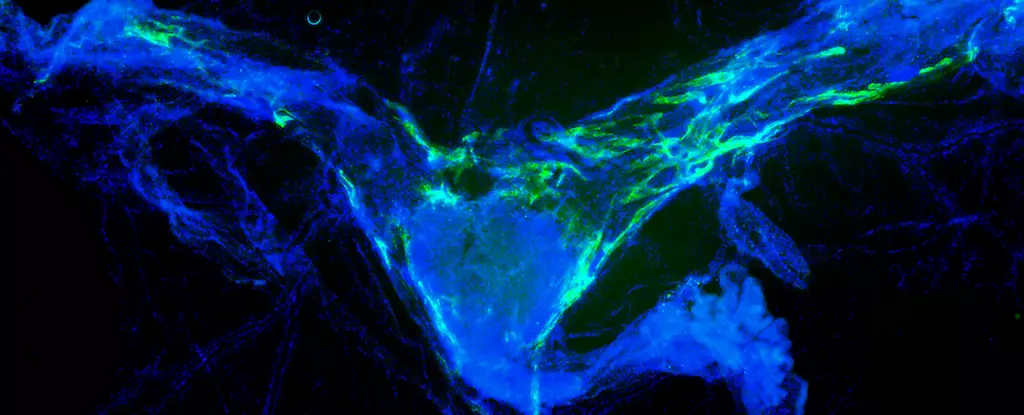As we delve into the complexities of the aging brain, it’s alarming to recognize that our cognitive faculties can deteriorate as crucial cleaning processes falter. The latest findings from Washington University in St. Louis reveal that the meningeal lymphatics—often overlooked vessels surrounding the brain—play a pivotal role in maintaining cognitive function. This begs the question: how can we harness this knowledge to combat age-associated memory loss and potentially stave off neurodegenerative diseases such as Alzheimer’s?
The study’s innovative approach promises transformative implications for how we think about brain health. With age, the body’s natural waste disposal mechanisms become less efficient. The meningeal lymphatics, which are entwined in the larger lymphatic system, are primarily responsible for clearing toxic materials, yet their importance remains underestimated in scientific circles. These findings challenge existing paradigms in neurobiology and offer a new lens through which we can view the aging process itself.
Hopeful Horizons for Neurodegenerative Disease
Imagine a world where the gripping fear of dementia no longer paralyzes our aging population. Through targeted protein treatments demonstrated in the study, researchers have successfully enhanced the function of meningeal lymphatics in older mice, leading to remarkable improvements in memory performance. This offers a tantalizing glimpse into how we might one day reorient our therapeutic strategies for neurodegenerative diseases.
What’s most fascinating is the connection drawn between the function of lymphatic vessels and the levels of interleukin 6—immunological indicators of distress within the brain. The reduction of this distress signal in treated mice highlights a critical relationship between effective waste management and overall cognitive health. To disregard the significance of maintaining a clean brain—a task traditionally relegated to the background of scientific inquiry—could mean missing a crucial aspect of combating neurological decline.
Breaking Barriers: Accessibility of Treatments
Another groundbreaking aspect of this research is the accessibility of treatment targets. By focusing on the meningeal lymphatic vessels—structures located outside the brain—scientists circumvent the notoriously difficult blood-brain barrier. This speaks volumes about how we can innovate therapies that promise to be both effective and less invasive. The complexity of neurological disorders, often compounded by delivery inefficiencies, raises the stakes for developing treatments that do not suffocate under the weight of physiological constraints.
Jonathan Kipnis’s assertion that “targeting a network of vessels outside of the brain…opens a window to develop more powerful therapies” could be a game-changer. This shift towards recognizing the importance of lymphatics in brain health could lead to novel approaches in medical research and treatment options.
Wasted Potential and the Need for Renewed Focus
This research emphasizes a pressing concern: the waste accumulation in our brains akin to trash piling up on train tracks, obliterating communication networks essential for cognitive functioning. How much longer can we afford to overlook the fundamental nature of cleanliness in brain health? The metaphor is both poignant and revealing. The very systems that support our mental faculties need active maintenance, yet they have long operated in the shadows of more glamorous research topics.
Also compelling is how this line of investigation flows so seamlessly into prior studies, suggesting that our understanding is evolving. The evidence that mouse memory could be enhanced through injections of cerebrospinal fluid ties neatly into this narrative, illustrating an interconnected system that emphasizes prevention rather than reaction.
The Future of Cognitive Function in Aging Populations
In this age of rapid advancements in neuroscience, one wonders if further exploration could lead us to groundbreaking therapies that empower aging populations. While we may not be able to revive neurons themselves, there is ample opportunity to optimize their functionality through focused interventions on lymphatic health. This line of research highlights an alarming oversight in neurological studies—a need to pivot from purely reactive therapies to proactive approaches that address the root causes of cognitive decline.
As we ponder the implications of these findings, it becomes clear that we are standing on the precipice of a paradigm shift in understanding brain health. The potential for reversing or delaying cognitive decline is tantalizing; the responsibility lies with researchers and policymakers alike to amplify these insights. The intertwining of waste management and brain function is a revelation that calls for immediate action and sustained investment in research pathways previously dismissed.

Leave a Reply